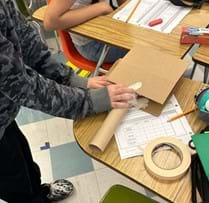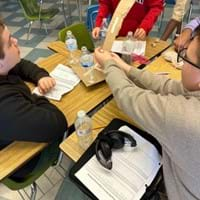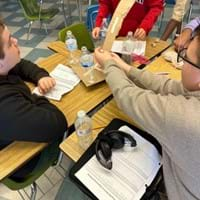Quick Look

Summary
Students use the engineering design process while learning about accessibility for people with physical disabilities in Egypt. Students are challenged to create a reusable prototype to help a wheelchair table tennis team pick up ping pong balls. Before building their prototypes, students research the trash and waste problem in Egypt, compiling a list of sustainable materials that can be used to build their devices. Students then individually brainstorm and plan at least two different devices before coming together in teams to develop one group prototype design. After building, testing, and improving their prototypes, student groups present their prototypes to the class.Engineering Connection
Mechanical engineers are vital due to their expertise in designing, analyzing, and optimizing mechanical systems and devices across various industries. Their contributions range from improving energy efficiency and sustainability in manufacturing processes to designing safer and more reliable transportation systems. By applying principles of physics, mathematics, and materials science, mechanical engineers play a crucial role in innovation and technological advancement, driving economic growth and improving quality of life.
Learning Objectives
After this activity, students should be able to:
- Identify and describe the steps of the engineering design process.
- Use the engineering design process to develop solutions for the assigned challenge.
- Explain the reasons for their selected designs and material choices.
Educational Standards
Each TeachEngineering lesson or activity is correlated to one or more K-12 science,
technology, engineering or math (STEM) educational standards.
All 100,000+ K-12 STEM standards covered in TeachEngineering are collected, maintained and packaged by the Achievement Standards Network (ASN),
a project of D2L (www.achievementstandards.org).
In the ASN, standards are hierarchically structured: first by source; e.g., by state; within source by type; e.g., science or mathematics;
within type by subtype, then by grade, etc.
Each TeachEngineering lesson or activity is correlated to one or more K-12 science, technology, engineering or math (STEM) educational standards.
All 100,000+ K-12 STEM standards covered in TeachEngineering are collected, maintained and packaged by the Achievement Standards Network (ASN), a project of D2L (www.achievementstandards.org).
In the ASN, standards are hierarchically structured: first by source; e.g., by state; within source by type; e.g., science or mathematics; within type by subtype, then by grade, etc.
NGSS: Next Generation Science Standards - Science
| NGSS Performance Expectation | ||
|---|---|---|
|
MS-ETS1-1. Define the criteria and constraints of a design problem with sufficient precision to ensure a successful solution, taking into account relevant scientific principles and potential impacts on people and the natural environment that may limit possible solutions. (Grades 6 - 8) Do you agree with this alignment? |
||
| Click to view other curriculum aligned to this Performance Expectation | ||
| This activity focuses on the following Three Dimensional Learning aspects of NGSS: | ||
| Science & Engineering Practices | Disciplinary Core Ideas | Crosscutting Concepts |
| Define a design problem that can be solved through the development of an object, tool, process or system and includes multiple criteria and constraints, including scientific knowledge that may limit possible solutions. Alignment agreement: | The more precisely a design task's criteria and constraints can be defined, the more likely it is that the designed solution will be successful. Specification of constraints includes consideration of scientific principles and other relevant knowledge that is likely to limit possible solutions. Alignment agreement: | All human activity draws on natural resources and has both short and long-term consequences, positive as well as negative, for the health of people and the natural environment. Alignment agreement: The uses of technologies and any limitations on their use are driven by individual or societal needs, desires, and values; by the findings of scientific research; and by differences in such factors as climate, natural resources, and economic conditions.Alignment agreement: |
| NGSS Performance Expectation | ||
|---|---|---|
|
MS-ETS1-2. Evaluate competing design solutions using a systematic process to determine how well they meet the criteria and constraints of the problem. (Grades 6 - 8) Do you agree with this alignment? |
||
| Click to view other curriculum aligned to this Performance Expectation | ||
| This activity focuses on the following Three Dimensional Learning aspects of NGSS: | ||
| Science & Engineering Practices | Disciplinary Core Ideas | Crosscutting Concepts |
| Evaluate competing design solutions based on jointly developed and agreed-upon design criteria. Alignment agreement: | There are systematic processes for evaluating solutions with respect to how well they meet the criteria and constraints of a problem. Alignment agreement: | |
| NGSS Performance Expectation | ||
|---|---|---|
|
MS-ETS1-3. Analyze data from tests to determine similarities and differences among several design solutions to identify the best characteristics of each that can be combined into a new solution to better meet the criteria for success. (Grades 6 - 8) Do you agree with this alignment? |
||
| Click to view other curriculum aligned to this Performance Expectation | ||
| This activity focuses on the following Three Dimensional Learning aspects of NGSS: | ||
| Science & Engineering Practices | Disciplinary Core Ideas | Crosscutting Concepts |
| Analyze and interpret data to determine similarities and differences in findings. Alignment agreement: | There are systematic processes for evaluating solutions with respect to how well they meet the criteria and constraints of a problem. Alignment agreement: Sometimes parts of different solutions can be combined to create a solution that is better than any of its predecessors.Alignment agreement: Although one design may not perform the best across all tests, identifying the characteristics of the design that performed the best in each test can provide useful information for the redesign process—that is, some of the characteristics may be incorporated into the new design.Alignment agreement: | |
International Technology and Engineering Educators Association - Technology
-
Apply the technology and engineering design process.
(Grades
6 -
8)
More Details
Do you agree with this alignment?
-
Create solutions to problems by identifying and applying human factors in design.
(Grades
6 -
8)
More Details
Do you agree with this alignment?
Materials List
Technology required:
- desktop and projector to display the Ping Pong Ball Retriever Engineering Challenge Presentation
- access to the following links in the slideshow:
Each student needs:
Materials to share among groups:
- plastic bottles
- plastic bags
- takeout containers (plastic plates/tin foil pans)
- aluminum foil
- straws
- rubber bands
- tape
- plastic silverware
- cardboard boxes
- scissors
- plastic cups
- string
Worksheets and Attachments
Visit [www.teachengineering.org/activities/view/uod-2847-ping-pong-ball-retriever-engineering-challenge] to print or download.Introduction/Motivation
In Egypt, a team of wheelchair table tennis players gets together multiple times a week for practice, camaraderie, and fun. But they need your help to make their practices run more smoothly!
During practice they use buckets of ping pong balls, but once the balls roll to the floor, retrieving them is a challenge because of the lack of core strength and mobility of most players. The team does have some able-bodied people to assist with ball pickup, but they are looking for a team of engineers to create a device to pick up the balls from the floor.
Your job is to create a lightweight, reusable device to aid the team in picking up the balls. First, you will conduct research to learn about common materials and resources found in Egypt. This will be things such as plastic bottles, straws, rubber, etc. You will want your device to pick up as many ping pong balls as possible at one time.
Your engineering team will follow the steps of the engineering design process, ultimately testing and redesigning your prototype. A successful device will not only be beneficial to the table tennis team, but could also be beneficial to individual wheelchair users who need help with ball pickup.
Finally, your group will pitch your prototype to the company (i.e., class), emphasizing why your design is the best. It’s important to note that the company is very big on including sustainable development goals in their designs, so you must include at least two such goals in your pitch.
Procedure
Background
Using the engineering design process, students will design a prototype to pick up as many ping pong balls from a seated position as possible. The device must be reusable and made from common materials found in Egypt. Students will work in groups to design, build, test and then redesign their prototypes based on data collected during testing to come up with the best prototype.
Before the Activity
- Review the steps of the engineering design process and review the slideshow notes.
- Make copies of the Ping Pong Ball Retriever Engineering Challenge Worksheet (one for each student).
- Have the Ping Pong Ball Retriever Engineering Challenge Presentation ready for presentation.
- Gather all necessary materials.
- Assign groups (if preferred).
During the Activity
Session 1 - Introduction
- Hand out one copy of the Ping Pong Ball Retriever Engineering Challenge Worksheet to each student.
- Display the Ping Pong Ball Retriever Engineering Challenge Presentation.
- Present Slides 2 and 3 and explain the design challenge.
- Go to Slide 4 and introduce the engineering design process. Be sure to point out that it is a cyclical process that may return to any step at any point in the process.
- On Slide 4, have students fill out the “Ask” box on their worksheet. Circulate the room and check for understanding.
- Go to Slide 5. One of the constraints of the challenge is to use commonly found materials and resources in Egypt. Show the students the video (https://www.dw.com/en/tackling-plastic-waste-in-egypt/video-63696217) and have them write down a list of materials and resources (in the research box on their worksheet) that might be easily accessible to someone in Egypt who might want to replicate the device they are creating.
- Go to Slide 6. Show students the supplies that you already have for the activity and add any others that they may have come up with (and that you are willing to supply and/or let them bring in to use).
- Go to Slide 7. Have students individually brainstorm and come up with two sketches on the Imagine portion of their worksheet. These should be detailed and labeled. Circulate the room to check for student understanding.
- Once all students have their two initial sketches drawn, break them into groups and go to Slide 8. Have all students present their two sketches to the group, and then have the group work together to come up with one final design/sketch.
Session 2 - Build, Test, and Redesign
- Start the session by reviewing the design challenge and the steps of the engineering design process completed previously.
- Let students know that they will have most of the time today to build, test, redesign, and get their pitch ready (show them Slides 8 and 9), but now add in one more constraint: The company they will be pitching their prototype to thinks the world's sustainable development goals (SDG) are very important. The company wants to see at least two of these addressed and included in the students’ pitch.
- Go to Slide 11 to review the final assessment rubric and introduce the SDGs. Each group should create and present a 2-3 minute pitch on how they used the engineering design process to create their device, demonstrate how to use their device, explain how they made it with the Egyptian user in mind, and explain what two SDGs it addresses.
- Go to Slide 12 and share the SDGs link (https://www.undp.org/sustainable-development-goals) with students.
- Have students work on building, testing, redesigning, and creating their pitch.

Student group working on their prototype together.

Session 3 - Pitch Day (Formative Assessment)
- Each group presents their 2-3 minute prototype pitch, including how they used the engineering design process to create their device, how their prototype works, how their prototype kept the Egyptian user in mind, and how at least two SDGs connect to their prototype.
- Grade students using the Ping Pong Ball Retriever Engineering Challenge Rubric. When testing the prototype, one student should sit in a chair and have ping pong balls scattered on the floor around them. Without putting their hands lower than the seat of the chair, they should pick up as many balls in their device as possible. A good prototype should not rely on a wall, chair legs, etc. to assist in the pickup.
Vocabulary/Definitions
engineering: Application of math and science to real-world problems.
engineering design process: Guides engineers to create a solution to a problem.
prototype: An early version of a product.
technology: The application of scientific knowledge of practical purposes.
Assessment
Pre-Activity Assessment
As a pre-activity assessment, spend a few minutes asking students what they know about the field of engineering and the engineering design process.
Activity Embedded (Formative) Assessment
Small group discussion/worksheet: As the groups work, circulate and check in with them for understanding. Individual student understanding can be evaluated by their responses on their Ping Pong Ball Retriever Engineering Challenge Worksheet.
Post-Activity (Summative) Assessment
Group Pitch: As a final summative assessment, student groups pitch their prototype to pick up ping pong balls and demonstrate what they have learned in the activity.
Making Sense Assessment: Have students reflect on the science concepts they explored and/or the science and engineering skills they used by completing the Making Sense Assessment.
Troubleshooting Tips
If students become frustrated with their prototype after the first test, or with how it looks, emphasize the importance of the redesign stage of the engineering design process. The redesign stage gives students a chance to reevaluate their prototypes and improve the final products to support their users.
Depending on class speed and need, putting a timer on the board for the individual engineering design process steps of imagine, plan, test, and redesign could be beneficial to keep the class moving and on task.
Another recommendation would be to have each student get a teacher signature in the bottom corner of every box on their Ping Pong Ball Retriever Engineering Challenge Worksheet before moving on, to make sure all students stay on task and complete the work.
Activity Extensions
Include a conversation on empathy and how their prototypes might work for some users, but not all. Relating this to the classroom, show similar things that might be seen in the classroom where adjustments are made for some students and how fair is not always equal.
Activity Scaling
Have advanced students redesign their prototype for table tennis players with more severe disabilities (e.g., their prototype has a higher required height due to players with much less range of motion than other players.)
For early finishers or advanced students: Have students search for grants for the AlHassan Foundation or another wheelchair organization to help further their outreach and connection.
Subscribe
Get the inside scoop on all things TeachEngineering such as new site features, curriculum updates, video releases, and more by signing up for our newsletter!More Curriculum Like This

This lesson introduces the concepts of momentum, elastic and inelastic collisions. Many sports and games, such as baseball and ping-pong, illustrate the ideas of momentum and collisions. Students explore these concepts by bouncing assorted balls on different surfaces and calculating the momentum for...
References
Hanemann, Ulrike. “Transforming Our World, Literacy for Sustainable Development, P. 41” UNESCO Institute for Lifelong Learning, 2015.
Omar, Toca. “Tackling plastic waste in Egypt.” Deutsche Welle, 10 Nov. 2022, https://www.dw.com/en/tackling-plastic-waste-in-egypt/video-63696217.
United Nations Development Programme. “Sustainable Development Goals.” UNDP, 2023, www.undp.org/sustainable-development-goals.
Copyright
© 2024 by Regents of the University of Colorado; original © 2023 Central State University and University of DaytonContributors
Abigail Wilker; Caroline WatersSupporting Program
Global STEM RET - Appropriate Technology for Developing Communities Research Experience for Teachers (RET), Central State University and University of DaytonAcknowledgements
This curriculum was developed under National Science Foundation RET grant numbers 1855231/1855239. Any opinions, findings, and conclusions or recommendations expressed in this material are those of the authors and do not necessarily reflect the views of the National Science Foundation.
Last modified: April 25, 2024






User Comments & Tips